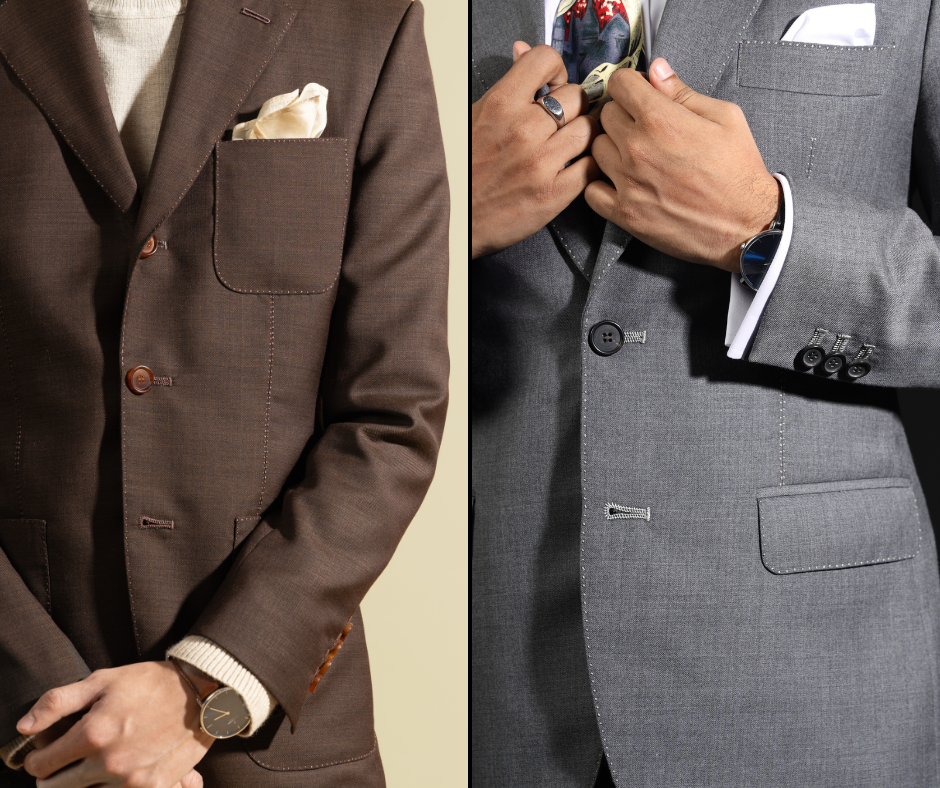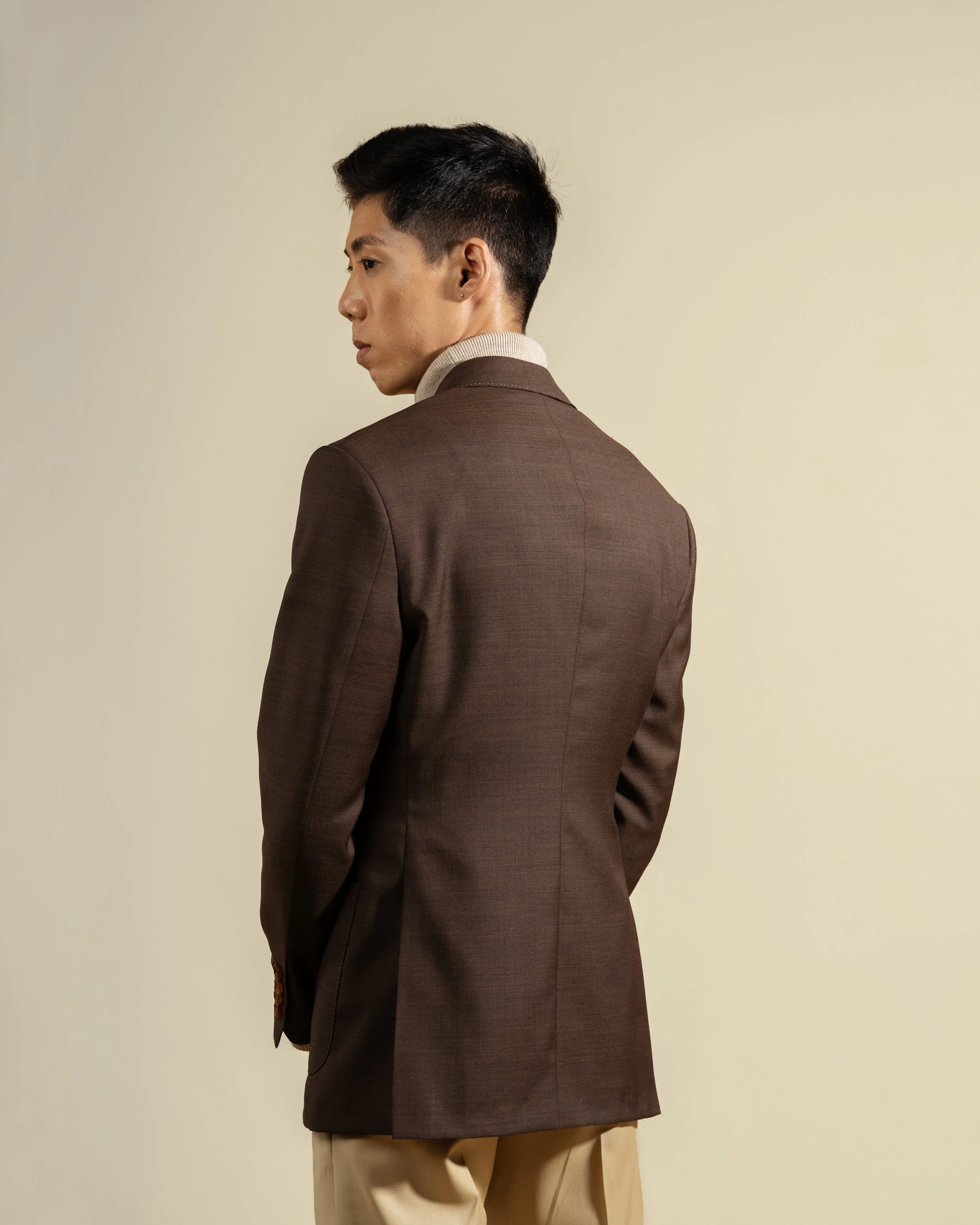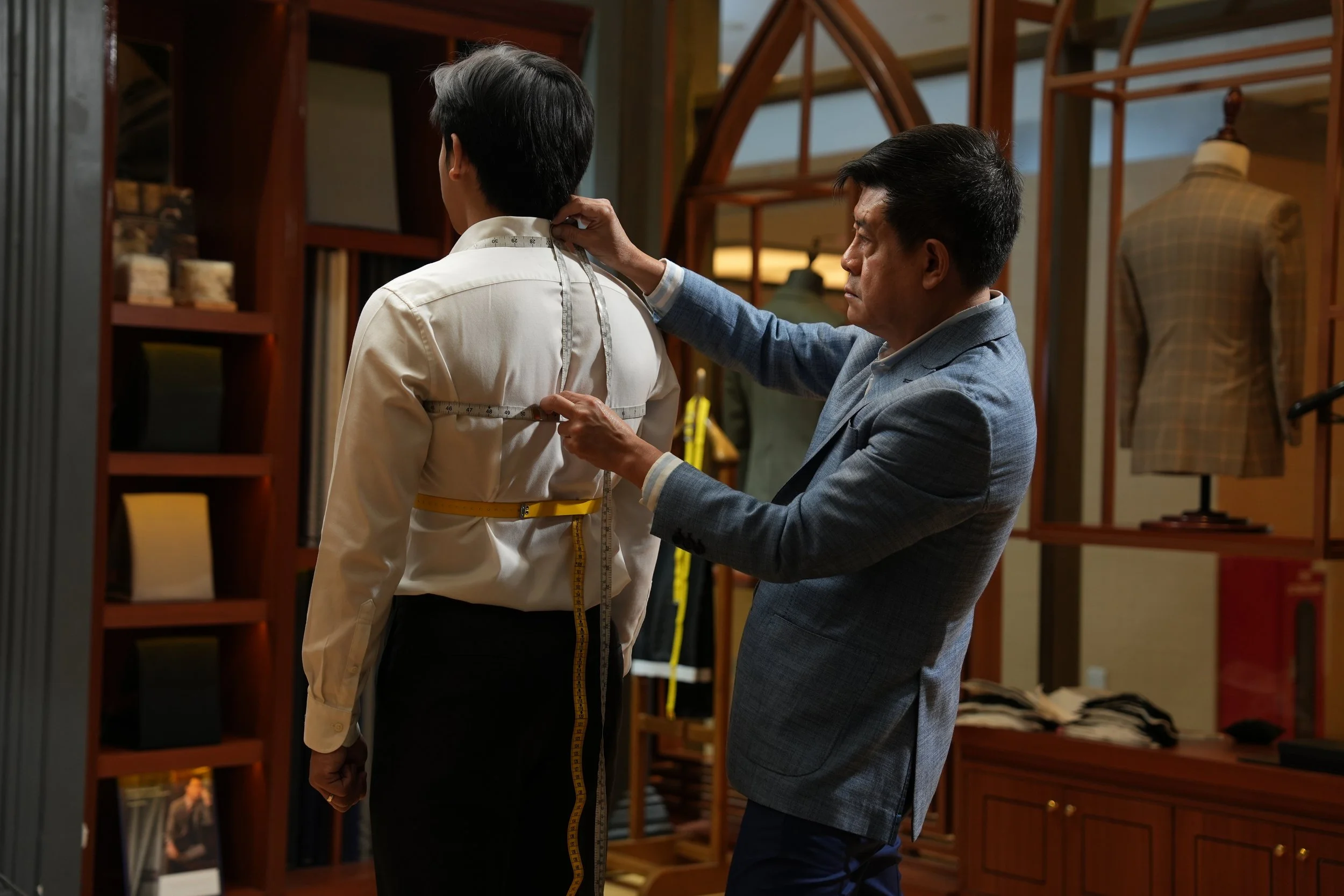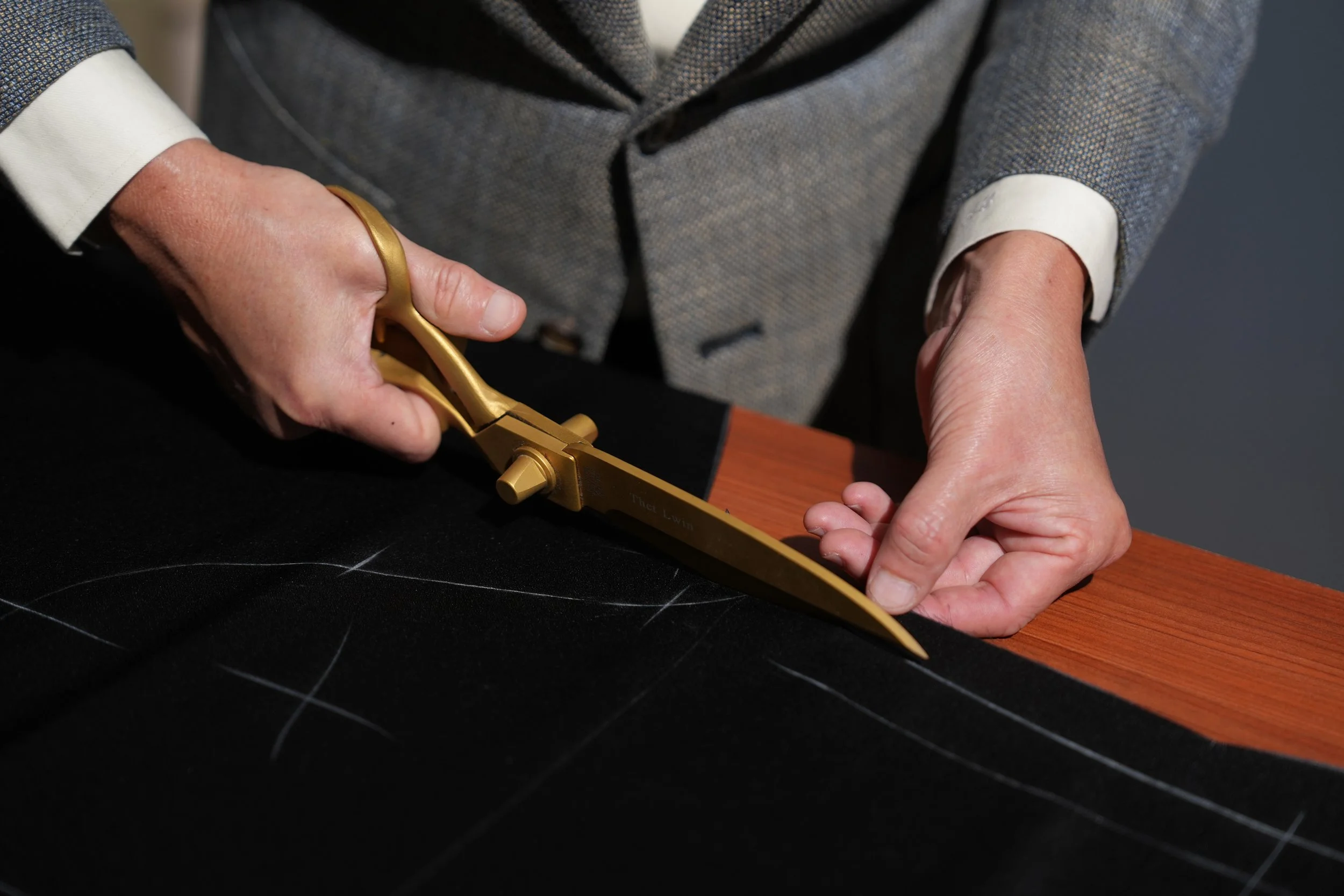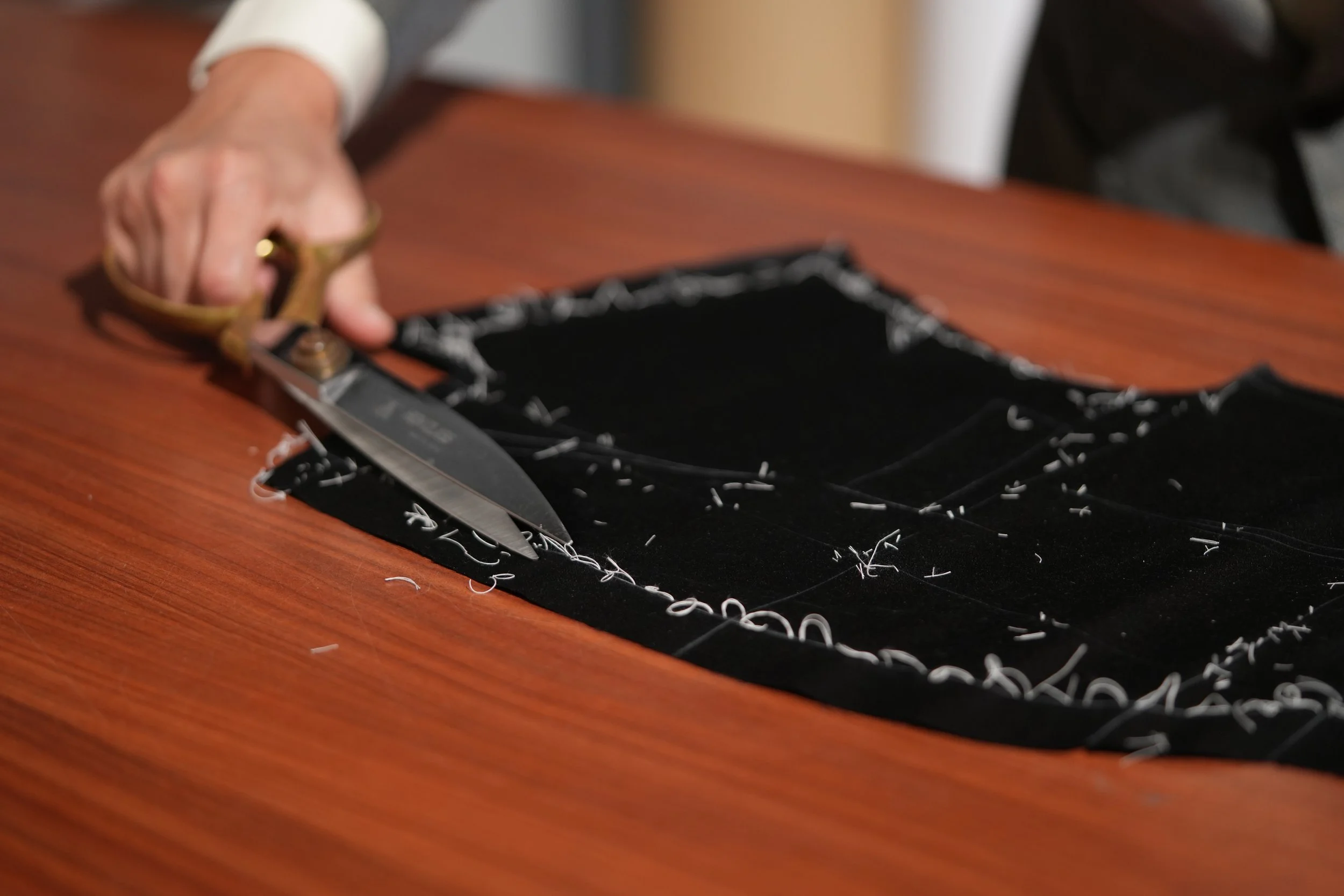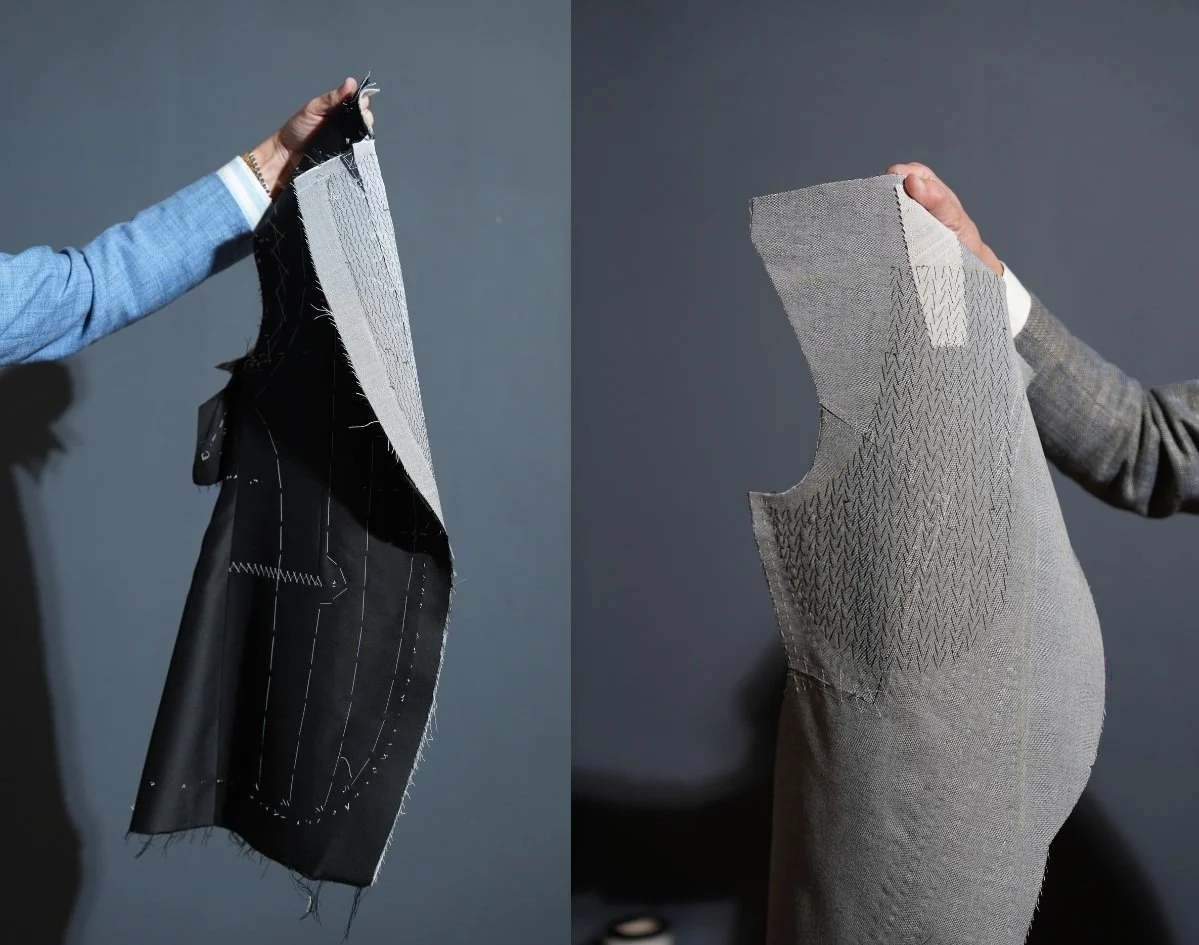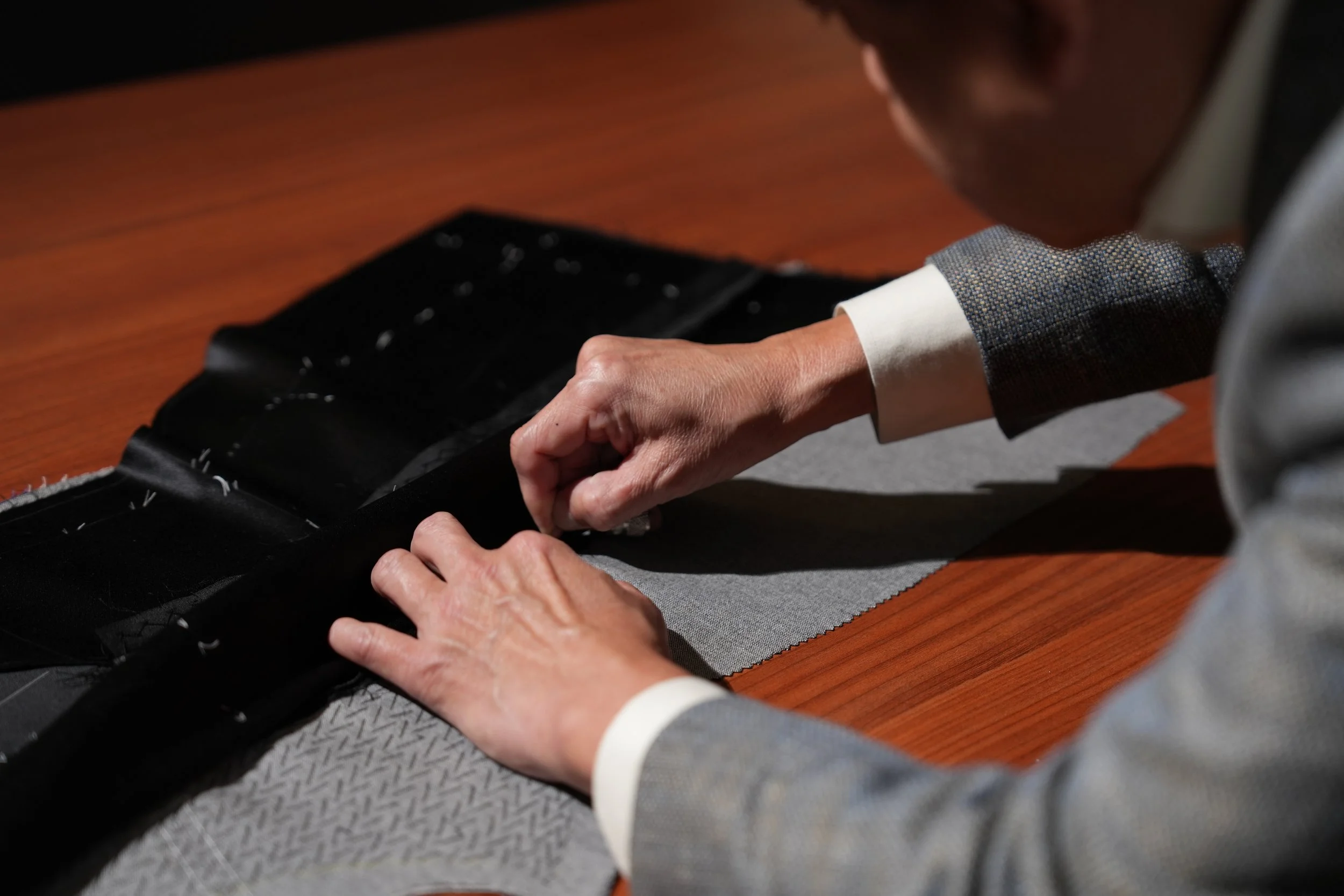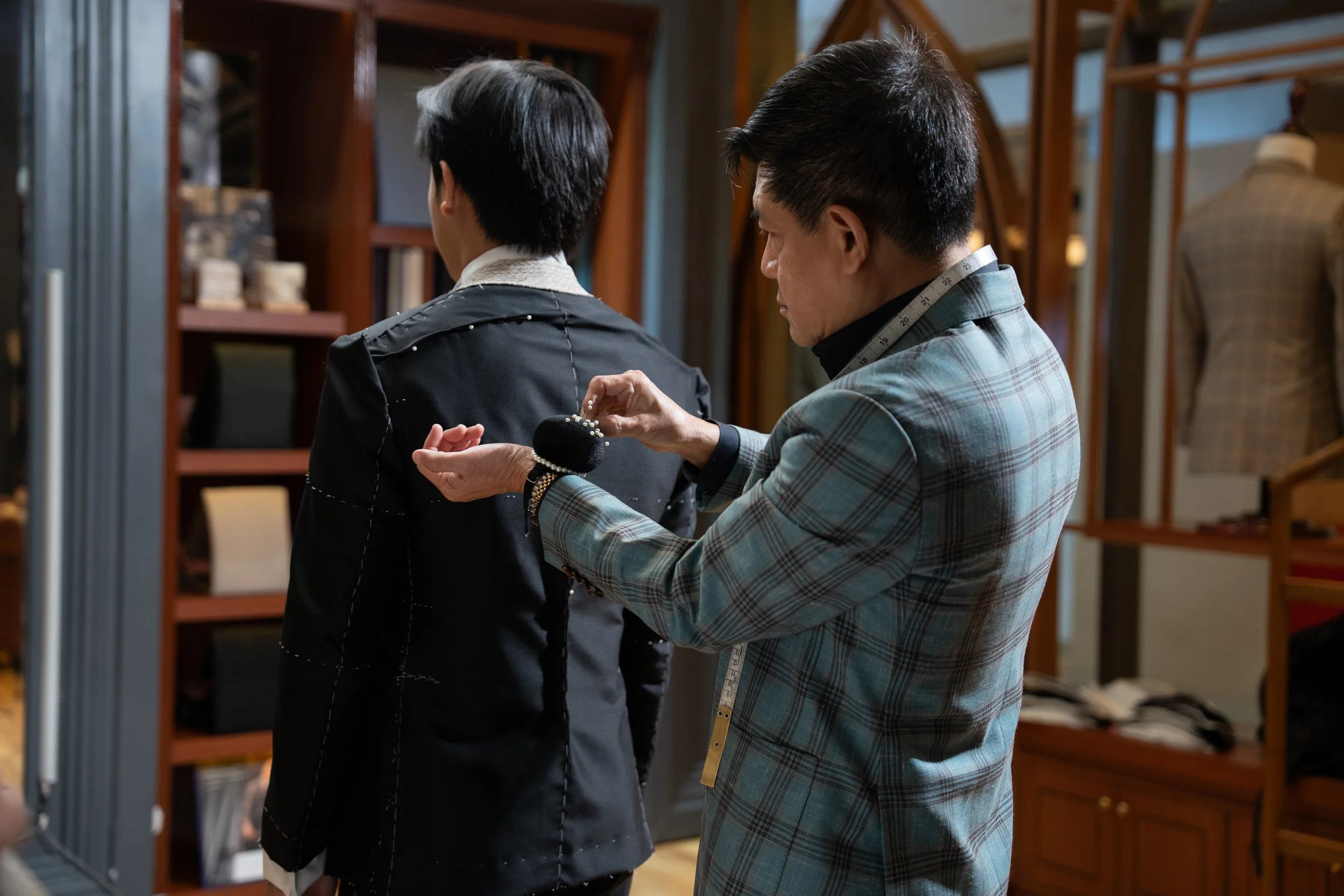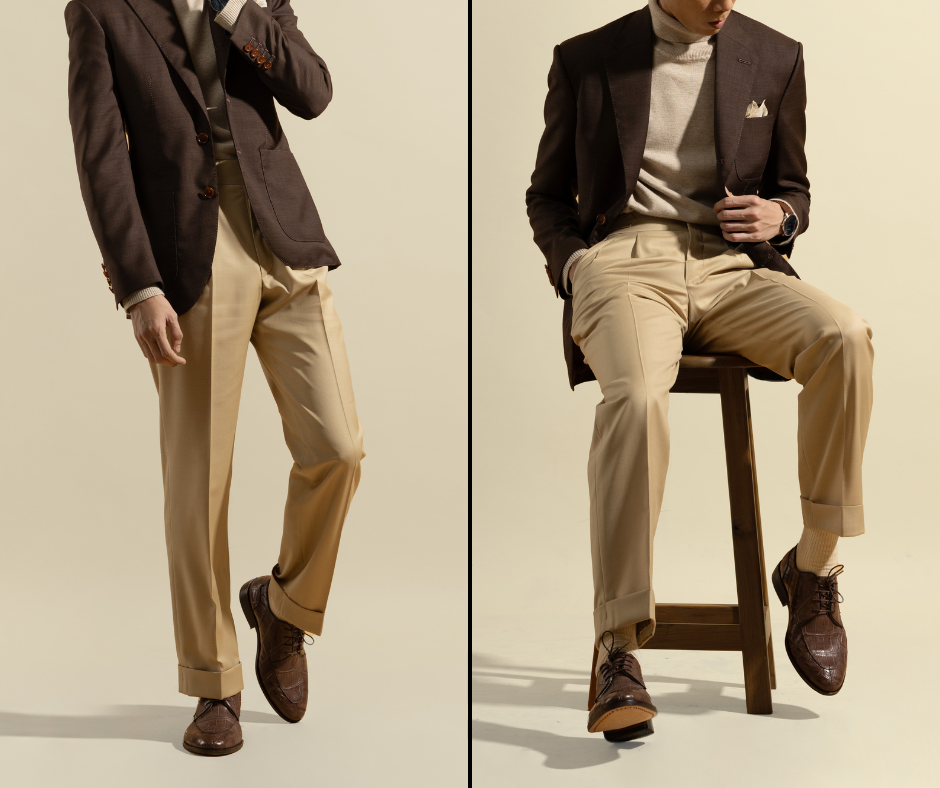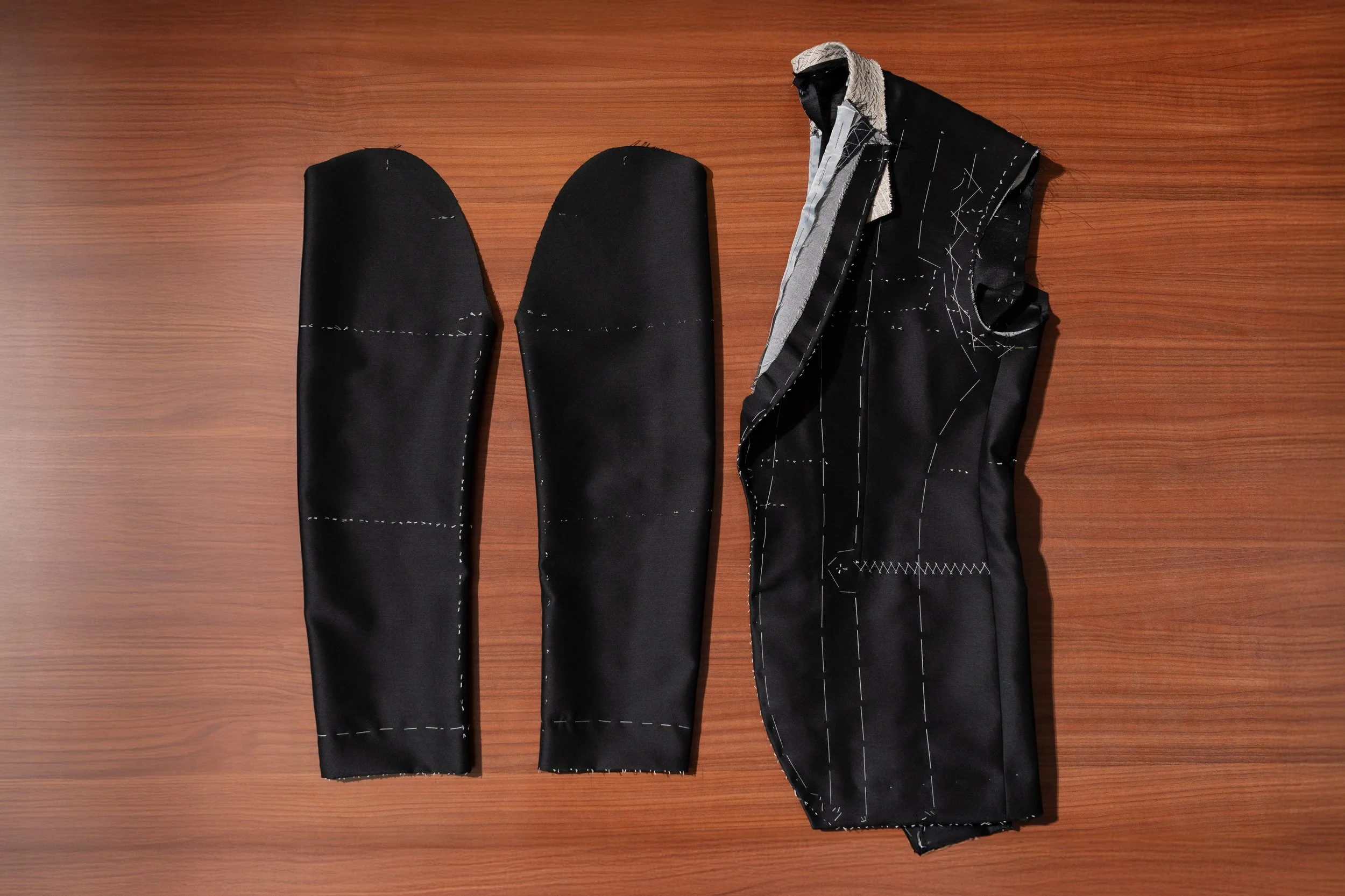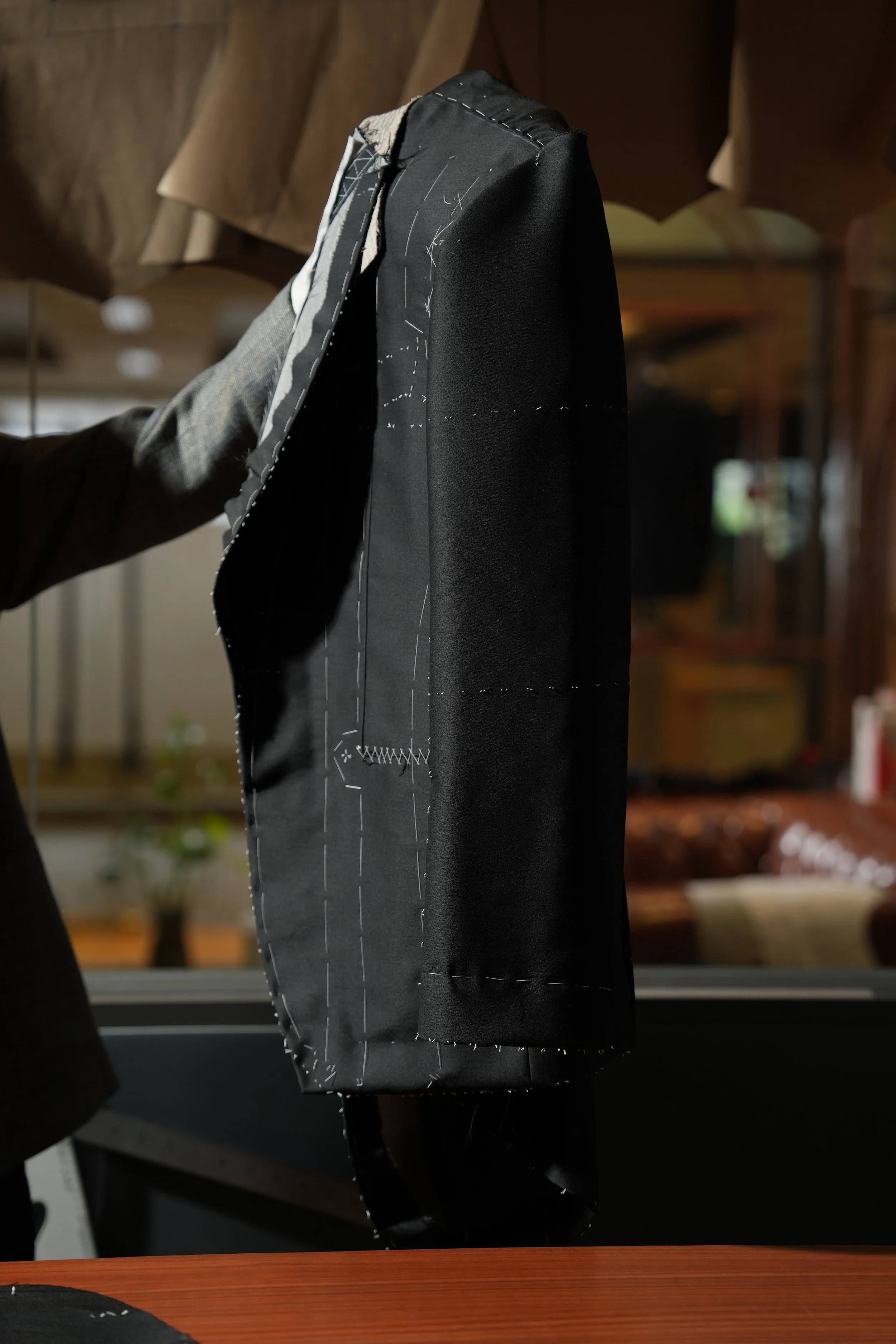Sein Shwe Bespoke Process
The Bespoke Process with us starts with an appointment. We then dedicate a portion of our schedule to finding out what you need and what your ideal suit is.
Where our tailors walk you through the fabric choice, colors, and styles.
Cloth or fabric choice is an integral process to define what you desire in your finished suit.
At Sein Shwe Bespoke, we carry a wide collection of the best cloth available from the UK and Italy’s top mills to be able to provide you with a suit for all your occasions.
A lighter cloth and those of open weave such as hopsack weave or a low gsm linen/silk blends would be ideal as a summer suit for tropical landscapes, predominantly in the South Asian area.
On the other hand, for those looking to make a statement, a moderately weighed worsted wool would make for powerful and commanding suits for business settings as well as handsomely draped tuxedos for those black tie events.
Consultation
Unlike the cloth you adorn, colour choice is easily discernible by even a quick glance from a passerby. Thus, it is key in either expressing oneself or fitting in with societal expectations in certain situations. Decades of experience serving customers with varying complexions have allowed us to become proficient in matching the right colors to any complexion and any occasion.
Color
Last, but not least, the fit and style. You may have heard the terms: skinny fit and slim fit, but neither these nor any other style such as loose fitting will come to your aid if we do not first understand how to define what fits. The clothes that drape over your figure are nothing without the figure underneath. The shape or shapes it forms as it slides elegantly from shoulder down to the ankles is what is called in essence, a silhouette. Each individual is built differently, hence each build is unique. With bespoke, we throw out those loosely predefined terms and carefully measure and define a suit for your unique posture. Fit and style is a conversation between us, the tailors and you the customer.
Fit and Style
Every reputable tailoring shop has a house cut.
At Sein Shwe Bespoke, our go-to is a soft shoulder, ample space around the chest and back for mobility and a slightly tucked waist for the jacket; followed by relatively high-waisted pants with slightly tapered bottoms for a flattering silhouette.
The Cut
Measurements define how the pattern to your commissioned piece will be made. Our highly skilled tailors take over 20 core measurements while taking note of any cut preferences and unique body features to craft the ideal suit for you.
Measuring
A proper bespoke suit is not possible without an experienced cutter drafting a personalized pattern from scratch in accordance with the measurements, preferences and vastly different body types.
It is in essence a complex mathematical solution for the cutters to solve in order to transform the two-dimensional fabric into a three-dimensional piece of clothing that not only fits perfectly but drapes handsomely and accentuates the customer’s natural shape. Your personalized paper pattern is stored at our premise as reference for your future visits.
Pattern
The paper pattern is then transferred onto the fabric of choice and cut into panels to begin constructing the garment. The extra steps of making a paper pattern first allows us to customize and make amendments easier as well as cut the cloth in utmost efficiency to avoid any cloth wastage. All panels cut with accurate precision lays foundation for the whole piece to start taking shape.
Cutting the Cloth
Although we have no doubt in our ability to construct the ideal suit for you, we never skip the important step of conducting a fitting; even the best painters start with a sketch. A fitting ensures that we can see how the actual suit would materialize and drape over each and everyone’s uniquely different form. The chosen cloth is loosely sewn together into the patterned shape to be adorned on the customer as we smoothen out the rough edges and perform any needed improvements during this stage.
Fitting Prep
A suit jacket cannot form its intended shape without a well-crafted canvas. The canvas supports and gives the front panel of the jacket its structure, a fullness in the chest, and forms the natural drape that falls on you.
Canvases are essentially the skeleton of the jacket; it is the hidden layer between the fabric we see and the lining that is the inside part of a jacket. Apart from serving its main functional purpose, the canvas may also be changed depending on the type of cloth and the intention of the jacket to be worn to provide a secondary function. For instance, we use a light hymo canvas (a blend of wool, viscose, and horse hair) imported from the UK for our jackets as it complements our light-medium weight worsted wool and linen jackets.
A well-made canvas that complies to a specific pattern of the jacket will not only create a handsome drape, but also mold the jacket around the wearer’s form over time as it retains the shape.
Canvas
After the canvas is loosely sewn onto the jacket, the next integral part of the jacket is to attach the sleeves with calculated precision. The sleeve attachment is meticulously carried out to minute detail within the correct angles and curves so that it complements the overall drape and silhouette of the whole suit.
With the jacket completed, we move onto basting the pants together and giving them a thorough military press to achieve a certain fall that we want. Finally, the customer is invited back to our premise for the first fitting, where they can start to envision their ideal suit’s formation.
Fitting Assembly
The first fitting is where the excitement happens. The customer is finally able to see themself adorning a draft of the piece they commissioned in the mirror and get an idea of what the final form will look like. Our tailors will then thoroughly discern any adjustments needed, while giving the customer a run down of the key points to look for in the ensemble. Along with the proportions and the fit, we take note of the customer’s preferences, asking them to move around the room. Observing the movements of the customer allows us to make amendments to the suit that make it adapt to each customer’s motion, providing utmost mobility and comfort without disrupting the ideal silhouette.
First Fitting
The jacket is the crux of the suit. The proper balance in the way it drapes on a person determines how it will turn out. The balance of a jacket differs from individual to individual through either the posture or the shoulder slopes. The tailor uses their experience to ensure that everything hangs in balance.
Next is the length of the jacket in proportion with the trousers and the sleeve length. With careful observation, the tailor makes adjustments according to the correct proportions and individual posture.
Finally, the horizontal aspects such as the chest, waist, and hips come into play. Our tailors open a dialogue with the customer to ensure that the silhouette and fit (of the lapel size, gorge line, and button placements) are to their liking, making sure that our experience helps them achieve the ideal form.
Jacket
Balance again comes into importance when it comes to the trousers. The correct balance helps the trousers avoid unnecessary creases as it drapes over the customer. Then, we look into the fit as it defines how comfortable the customer is, especially around the waist area. We keep in mind the customer’s preferences throughout the process and here is no exception. Our tailors keep note of the width, length, and design preferences of the customer and give our advise on how we can best attain the overall silhouette that the customer desires.
Trouser
After the first fitting, we disassemble the jacket and trousers into separate panels that are sent back to the cutting board where necessary amendments are made. The changes are further reflected on the original paper pattern for future reference.
Disassembly
A well made canvas is nothing without proper hand-pad stitching. Our tailors carefully hand stitch each suit with detailed balance to produce proper pad stitched lapels that have a beautiful natural roll that is simply elegant. The lapel is not the only functional area, as the chest is also pad stitched together with ample ironing to shape the cloth into a fuller form in the chest area.
Pad Stitching
The lining is the most personal part of the jacket. It is what is between you and the jacket itself. At Sein Shwe Bespoke, we almost exclusively use Bemberg Cupro lining, a natural fiber that is incredibly lightweight and breathable–ideal for Myanmar’s tropical weather. The lining is sewn onto the inner parts of the jacket as well as the sleeve and provides you with comfort and confidence.
The Lining
For bespoke tailors, attaching the sleeve is a delicate and difficult process. Our tailors take pride in being able to achieve the perfect sleeve attachment through decades of hard-learned effort and coordination with the cutter. The sleeve is sewn onto the jacket body with immaculate precision to form the jacket’s shape.
Sleeve
The jacket collar has two layers of cloth: the top collar which we see is of the same material as the jacket body, and the under collar which is made of a stronger specialized wool called Melton. The under collar is hand pad stitched along with the canvas so as to be shaped as needed to go with the jacket. Pad stitching shapes the collar to point downwards and curl-in neatly, making the collar hug its wearer to create a natural form.
Collar
During the second fitting, the suit is almost at its intended form. Here, we do a final check to see if the customer is satisfied with the overall silhouette and fit. It is a conversation where our tailors listen to your feedback and provide our own advice before making the finer and final adjustments to the suit.
Second Fitting
The Finer Details


